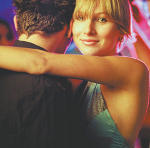 |
ROUND DANCING — CHOREOGRAPHED BALLROOMEDUCATIONAL ARTICLESMAJOR SECTIONS: Figures | Articles | Links | Alph. Index | Search | Home |
|
|
Round Dancing Is A Partnershipby Harold & Meredith Sears We hope that your first reaction
to our
title is, Of course dancing is a partnership! Of course we are
dancing together. This is not line dancing. But, there are three
habits that get in the way of smooth, comfortable partner dancing,
and, of course, there are three strategies that can counteract those
habits and make our dancing more fun. They are cooperation,
collaboration, and compromise -- the three C's of partner dancing. Sometimes, we dance our steps and
figures with less attention to our partner than we need to give.
There are probably several reasons for this self-centeredness. In
learning a new dance, we usually hear about the steps individually.
We step forward. Our partner steps back. The man thinks about the
man's steps, and the lady thinks about the lady's steps. We may even
practice separately from our partners -- the men get up and try their
part; then the ladies get up and do theirs. Of course the cues come
to both partners, so each can independently dance their own figures.
But an independent approach to dancing can lead to pushing and
pulling, tugging and jerking. One might forge ahead, leaving the
other behind. We definitely want to dance as one unit, not two. We
need to cooperate. So, yes, learn your
steps, your part, but learn your partner's part, too. If you know
that in a Telemark To Semi, the lady's second step is a Heel Turn,
then you can think about not stepping long or wide and so pulling her
off that turn. If you don't know her steps, then you can't even think
about that issue. If you try to use lead and follow
techniques, then another uncomfortable habit is leading with
strength, with singleness of purpose, with determination -- and then
expecting the follower to keep up, no matter what. This is a
self-centered, autocratic, caveman-kind of lead and follow, and it is
not fun for either partner. Of course, the follower is going to be
jerked, dragged, and generally beaten up. But the leader is going to
meet resistance, work hard, and feel frustrated, too. We need to collaborate. Ladies, as the
traditional
follower, you are taught early to feel your partner and to respond to
his lead. But, men, you too must feel your partner, feel if she is on
balance, feel where she is in her sequence (which you know and can
visualize), and then you need to adjust your movements and your
subsequent lead to complement her movements. We need to work together
on this. At least one teacher has bluntly said that the man needs to
follow too, and that is simply and straightforwardly true. The leader
guides and supports his partner, makes it easier for her to do what
she needs to do, but he must respond to her movements and adjust. She
is the picture; you are the frame. She is the performance; you are
the stage. She is doing the work; you need to assist however you can.
An old admonition is to lead what you want but dance what you get. Typically, we try to take each
step and
dance each figure exactly as written and precisely on the beat. We
waltz 123, and foxtrot SQQ, firmly on the beat of the music. Dance
music is metronomic, but human movement and especially couple
movement can't be so precise. The next music beat comes inexorably,
but you might not be quite ready or your partner isn't quite in
position, and you need to wait just a moment for the next step. We
need to compromise on this matter of
time.
We speak of "stretching a beat." This is spending a little
longer on one step or movement than is strictly "allowed"
in the music or on the cue sheet. If you need the time, use it! It's
okay. It's simply true that some steps in a figure are easier or less
important than others. In a waltz Hover, dance it 1 2
3. Stretch the 2. This is where you are rising and blending to
semi-closed position. It needs the time and it deserves the time. The
first and third steps are just forward -- they can be emphasized
less. In our dancing, we need to be flexible and forgiving. Dancing isn't a team sport, but it is a couple sport, and we need to work together. In every dance that you do, remember the Three C's -- cooperate, collaborate, and compromise. Your play together will feel so much better.
A
version of this
article was
published in the Washington Area Square Dancers Cooperative Association
(WASCA) Calls 'n' Cues, November, 2011; reprinted CRDA Round Notes, October 2011 and January 2014.
If you would like to read other articles on dance position, technique, styling, and specific dance rhythms, you may visit the article TOC. Past DRDC Educational Articles archived here. Go beyond this site. Find other references on our Sources and Links pages.
|
 |
|
|